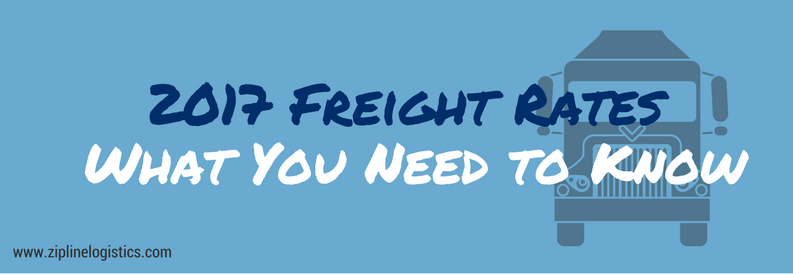2017 is going to be an interesting year for the transportation and logistics industry. Political, regulatory, and economic factors are all in flux, pointing to an increase in demand, tightening of capacity, and rate impacts for all modes of freight transportation.
New regulatory updates are seemingly published daily and it can be overwhelming to know what laws or predictions will impact your business. Here are some of the major drivers we are watching in the year ahead, curated with our specialized customer base in mind.
Timely Economic Drivers for 2017 Transportation Market
ELD Mandate
There is chatter that President Trump and nominee for Transportation Secretary, Elaine Chao, will significantly reduce regulation, with possible targets on simplifying hours of service rules and reversing the electronic logging device (ELD) mandate. While the chances of deregulation are real, we have no doubt that the ELD mandate will be upheld and will go into effect Q4 2017. Industry predictions for the impact on capacity vary from 3-5 percent to 6-10 percent, any of which will have a ripple effect on pricing.
Promised Infrastructure Improvements
President Trump’s proposed trillion-dollar, multi-year infrastructure program says it will address deficiencies in the U.S. highway network, ports, bridges, junctions, sewer systems, etc. Over the next four years, we hope to see roads, tunnels and bridges rebuilt, in addition to achievements of decreased congestion and more truck parking.
Yet, there is much debate around funding for these massive initiatives. Whether public or private investment, the transportation industry will ultimately become responsible. We expect increases in taxes, fuel costs, and/or insurance premiums, which will cause a certain rise in rates for 2017.
Additionally, trucks will be needed for transport of building supplies, causing another strain on capacity. Nation-wide infrastructure improvements are a positive long-term initiative, that will result in some short-term capacity shifts and price increases.
Trucking Labor Market Uncertainty
Truck driver compensation and conditions are improving, but with promise for more local job creation in construction and manufacturing from President Trump, there’s potential for a negative impact on the number of willing drivers. Reintroduction or boosts in manufacturing and construction jobs may pull labor out of the trucking market.
For example, in Illinois, when more than 100,000 manufacturing jobs were lost over the last decade, 21 percent of the displaced workers moved into the transportation and logistics industry, more than any other sector, according to researchers at the University of Illinois at Chicago. This fact could potentially be reversed in coming years.
Increase in Demand for Freight Transportation
The U.S. Department of Transportation estimated that in 2010 each American required the movement of 40 tons of freight annually, that number has now jumped to 63 tons annually. Consumers not only have more spending confidence than they did a few years ago, they also have more options with e-commerce booms.
This increase in demand will continue to put upward pressure on the freight market. Additionally, if our economy shifts to be more export-driven with increased manufacturing, there will be an increase in product touch points and need for domestic transportation.
This all plays favorably for the growing transportation industry. 3PL relationships with carriers will become more important as demand for trucks increases and access to capacity decreases.
Fuel Tax Rate Changes
11 states are scheduled to have notable increases in their fuel tax rates, some doubling. Here’s a breakdown for the states impacted. This increase in cost will be felt by everyone in the supply chain, including the end consumer of grocery and retail goods.
Reefer Capacity Concerns from Food Safety Modernization Act (FSMA)
With new FSMA handling requirements going into effect April 2017, temperature controlled vehicles may have longer dwell times and there may be fewer drivers willing to take on the extra steps and liability of food transport, increasing an already strained sector.
Smaller carriers are less likely to have current-generation equipment that offers built in telematics, and will have to either invest in third-party systems like SkyBitz, new trailers, or take extra steps to obtain temperature records from Carrier or Thermo King.
Warehouse Space Shortage Eases
While Zipline Logistics doesn’t own warehouse space, we consult with clients on warehouse locations and go in and out of DCs daily. Many of our clients have felt the pinch of increased warehouse costs and space. In 2017 we expect the shortage of warehouse space will become less of an issue, with construction of facilities finally catching up with demand.
How to Navigate the 2017 Freight Market With Your 3PL
Truckload carriers have operated on razor-thin margins for the last decade, and as demand shifts in their favor, it should be expected that carriers will pay that upward rate pressure forward. Conversely, shippers will want to maintain the lower costs they’ve operated with in recent years. It will be the role of 3PLs to help navigate this shift.
In these markets, the delta between carriers pushing for rate increases, shippers focused on maintaining historically low costs, and 3PLs attempting to grow market share is where disastrous service failures happen.
Ensure you have a 3PL that acts as a partner with your best interests in mind. Rather than shopping for the lowest rates, they can help you plan for price increases, making the impacts on your business as minimal as possible. A holistic approach that considers 2017 price drivers not just in transportation, but the entire supply chain, will help make political, regulatory, and economic factors less detrimental, and can even uncover new opportunities or cost savings.


